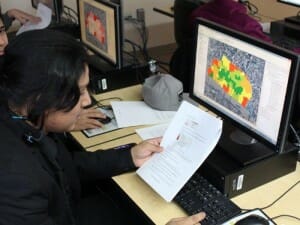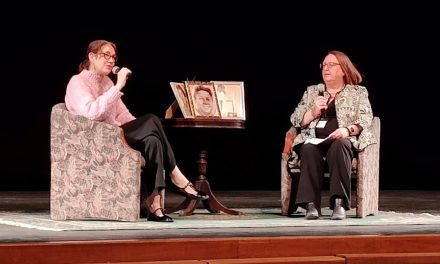There are approximately 13,605 Yellow Taxi Cabs in New York City making more than 500,000 trips per day. Jonathan Peters, PhD, took note of these gargantuan numbers and after more than 48 months of collecting data, in partnership with researchers at Arizona State University, the College of Staten Island (CSI) professor has a little more than 600,000,000 records in his database.
Dr. Peters has been studying urban issues such as New York City taxi cabs, the bike-share programs, and what folks are tweeting in City Starbucks locations.
His presentation, “Big Data Analytics Examples and Issues Exploring Travel Behavior,” outlines how Dr. Peters uses Geographic Information Systems (GIS) and the High-Performance Computing Center (HPCC) at CSI. The lecture kicked off the agenda for the CSI HPCC Tour.
It was truly a big day for big data as 19 New Dorp High School (NDHS) students traveled to CSI to learn more about how data from devices like Global Positioning System (GPS) units are used today.
Accompanied by their teacher, Christine Rivera, and NDHS Assistant Principal Salvador Contes, the young crowd of ninth and tenth graders experienced a day of college-level learning and exploration. The event was sponsored by the Office of Information Technology.
“I enjoyed the event at CSI because it was intriguing and I found it was a fun topic to learn about. I learned how GPS systems work and how technology has evolved into a smarter and quicker way of doing things. This field of study really makes you wonder how far the human race has advanced and how much more it can improve,” commented Rodrigo Balderas, a 15-year-old junior from NDHS, who plans to study software/hardware engineering in college.
“The most interesting part of the day was when we learned how all of modern-day technology can be used to track anyone or anything quick. This is a very interesting experience and might just change my future plans,” said Balderas, a Dongan Hills resident who grew up in Brooklyn.
Urban Policy Analyst Nora Santiago helped coordinate the event and also introduced students to GIS. Following the lectures, students worked on two hands-on GIS projects: the Great Fire of London, 1666, in which students completed GIS spatial queries, walking through the historical event step by step as the fire was spreading through the streets of London. In the second project, students created a map of the historical fire at the end, and the Great Plague of London, 1665, where they mapped the number of weekly deaths due to the plague by parishes as it was reported for the Bills of Mortality. Students were also able to include a graph of the total number of burials per week. They then created a map of the historical plague.
The participating students are a part of a smaller NDHS learning community called Business and Technology.
“These events provide our students with the opportunities of visiting a college and to meet first-hand, professors discussing new and up-to-date information on majors that align to our schools Smaller Learning Community (SLC) themes,” noted Contes, adding that the collaboration between NDHS and CSI has created a “trust within both schools.”
“With trust, students are more comfortable with sharing their thoughts and potentially seeing the multiple opportunities CSI provides, in turn, strengthening our collaborative efforts into a stronger partnership,” said Contes, a three-year veteran at NDHS.
The next stop was the HPCC where students heard from Paul Muzio, Director of the facility, who discussed High-Performance Computing.
The curious tech-savvy teens also visited the HPCC server room. Eyes wide and ears covered, students were able to see and hear the massive energy and processing of the system.
“Students attending this event were able to get a real-world experience of what it is like to participate in a college course at CSI. All of the students on the trip take interest in technology (both software and hardware), and by allowing them to use the computer lab to create their own projects, as well as, get a tour of the server, the students were able to see that they don’t need to go far away to get a quality education on what they love. Instead of traveling, they can get a quality education right in their own backyard,” commented Rivera.
The day culminated with a pizza lunch and lots of interesting tech banter.
“On the bus back to school, there were some conversations on how interesting the software was and the many things CSI can accomplish with the HPCC. Events like this one illustrate how CSI provides just as valuable, if not more valuable a post-secondary education than most colleges,” Contes said.
Rivera agreed that, “This collaboration with CSI helps students to see that the College has so much to offer in regard to obtaining a quality education. It allows the students to obtain awareness of what is offered right here on the Island and how they can take advantage of it when it is time for them to attend college.”
Patricia Kahn, PhD, CIO, and Assistant Vice President for Information Technology Services and the High-Performance Computing Center, noted that, “The College of Staten Island is excited to offer opportunities to high school students to encourage STEM careers. Providing exposure to the HPCC and the research that is currently being conducted using this facility, will hopefully encourage our youth to consider a career that uses computational thinking.”
The 12th annual GIS day will be on November 15, 2017 when organizers hope to extend the invitation to other high school students on Staten Island and introduce them to GIS technology.









![[gallery] Graduating Vets Honored](https://csitoday.com/wp-content/uploads/2012/05/Veterans_Recognition_Luncheon_5_30_2012.jpg)












